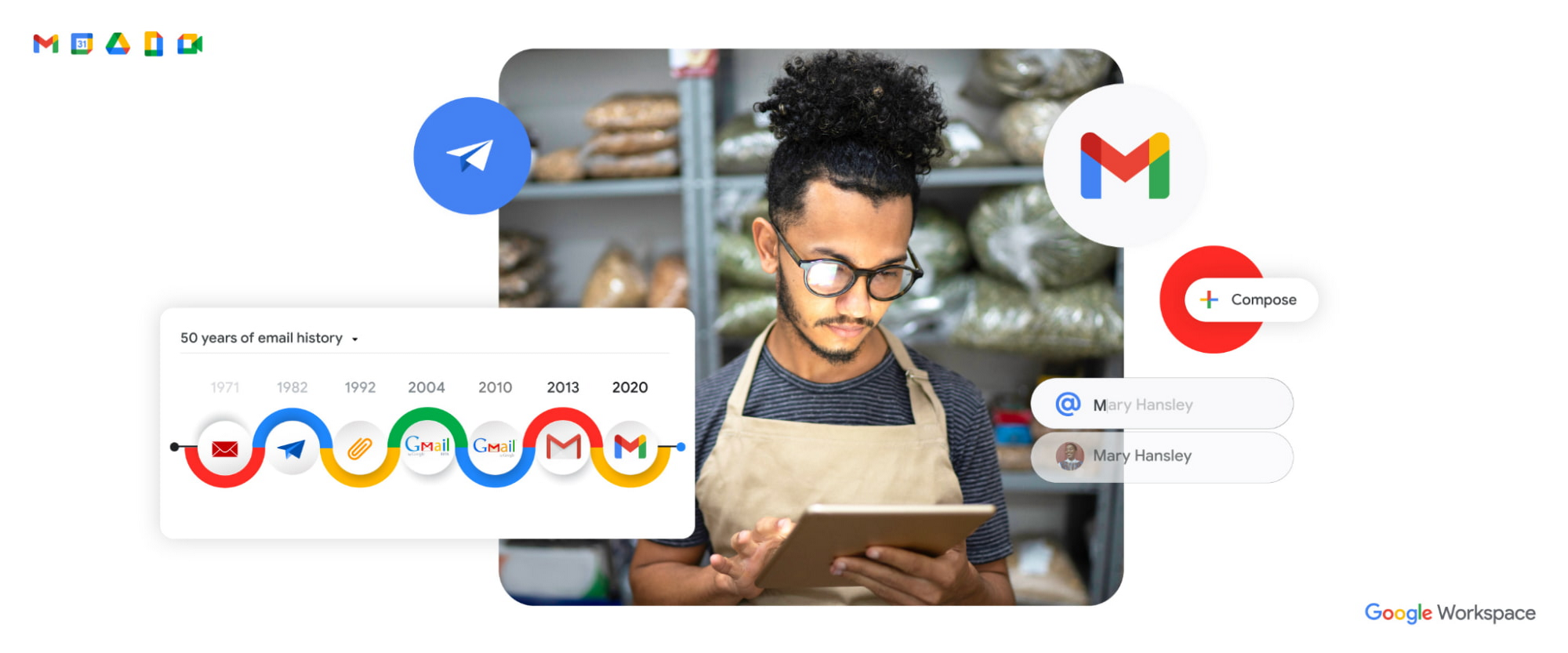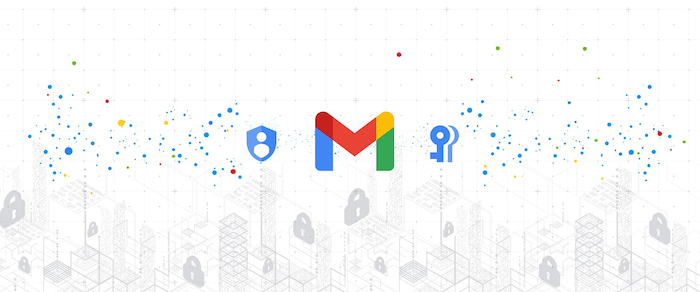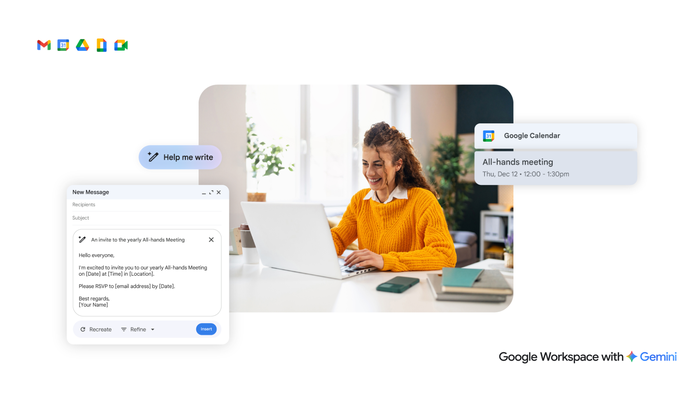As email turns 50, the @ symbol continues to fuel collaboration

Dominic Smith
Content Lead, Google Workspace
As email turns 50, we look at where it’s been and where the @ symbol is headed next.
Try Google Workspace at No Cost
Get a business email, all the storage you need, video conferencing, and more.
SIGN UPLike many technical breakthroughs, email began as an experiment.
In 1971, Ray Tomlinson, a recent graduate of MIT, was looking for interesting problems to solve. He was hired to help build ARPANET, the precursor to the modern internet, and during his first year on the job he came up with a simple yet ingenious way to send messages between networked computers. He created an address system that put a user’s login name in front of the @ symbol and the computer hostname on the other side. Although the first successful test message traveled just 10 feet between computers, it became a technological milestone.
Tomlinson, who died in 2016, could never remember exactly what was in that first message, but in interviews he speculated that it was “something like QWERTYUIOP” — the top row of letters on an English-language keyboard.
Today we’re joining with Amazon, Microsoft, Yahoo Mail, The Messaging, Malware and Mobile Anti-Abuse Working Group (M3AAWG) and others in celebrating Tomlinson’s innovation and 50 years of email at #QWERTYUIOP and #50yrsofemail.
Gmail is born
More than 30 years after Tomlinson’s breakthrough, a Google engineer named Paul Buchheit conducted his own experiments with email. In a 2005 blog post, Buchheit described the problem he was trying to solve:
“My email was a mess. Important messages were hopelessly buried, and conversations were a jumble…I couldn't always get to my email because it was stuck on one computer, and web interfaces were unbearably clunky. And I had spam. A lot of it. With Gmail I got the opportunity to change email — to build something that would work for me, not against me.”
Buchheit created Gmail as a browser-based email program that allowed users to easily search their own messages. He wasn’t sure if it was going to be for everyone, but when he released a beta to fellow Googlers they were fans of its search and storage capabilities. And when Gmail launched on April 1, 2004 with lightning fast email search and a storage limit of 1 GB—500 times more than prevailing inboxes of the time—a lot of people thought it was an April Fool’s Day hoax.
Gmail is now part of Google Workspace, the integrated solution that spans Docs, Slides, Sheets, Meet, Chat, and more—and that’s home to more than 3 billion global users. Google Workspace is where people connect, create, and collaborate at work, at home, in the classroom, and everywhere in between.
How email got safer


Paul Buchheit wasn’t the only person getting a lot of spam in his inbox back in the early 2000s, and the issue of unwanted messages—from spam to phishing attempts and malware—has grown worse over time. On any given day, Google Workspace now prevents more than 100 million harmful emails from reaching Gmail users.
“Our machine learning models have evolved to understand and filter new threats, and we continue to block more than 99.9% of spam, phishing, and malware from reaching our users,” said Neil Kumaran, Senior Product Manager, Counter-Abuse Technology.
Creating a secure-by-design approach to email that respects the privacy of individuals has been a core principle for Gmail for years, yet our product designers continue to push safeguards to new levels. For example, Google Workspace recently announced support for the Brand Indicators for Message Identification (BIMI) in Gmail, which allows organizations to validate the ownership of their logos as part of authenticating email messages. BIMI provides email recipients and email security systems increased confidence in the source of emails, and enables senders to provide their audience with a more immersive experience.
How email became more powerful
Over time, Gmail has moved beyond just email and towards becoming a central hub, supporting all the ways people communicate today.
“During the first part of the pandemic, we made Google Meet free for everyone and launched the ability to start or join a video call directly from Gmail. It was a way to keep people connected when many couldn’t be together in the physical world,” said Sanaz Ahari, Senior Director of Product Management for Google Workspace.
We’ve also been focused on helping people better manage their time and attention with features like templates, offline email, and dynamic emails, which let you take actions like approving a workflow directly from an email message. Recently, we also announced AppSheet in Gmail, a new feature that lets you use custom-built no-code applications, created in AppSheet, directly in your inbox as a dynamic email.
Meanwhile, Smart Compose and Smart Reply make emailing faster and easier, with suggestions as you type.


The @ symbol comes of age
Before Ray Tomlinson turned the @ symbol into a vehicle for connecting people in the early digital age, the symbol spent centuries in obscurity. Referred to as “the snail” by Italians, and the “monkey tail” by the Dutch, the humble @ doesn’t have a clear origin story, but we know it was used in shipping records during the 16th century.
While the most obvious modern uses of the @ symbol have been in email addresses and Twitter handles, it’s recently become a crucial part of transforming collaboration in Google Workspace with smart canvas.
“Today, if you type @ into a Google Doc, Sheet, or Slide, you’re going to get a whole host of collaboration possibilities. You might get recommended files, or people, or meeting invites that allow you to connect to the right conversations with @-mentions, and it’s all powered by AI and machine learning. That’s a big step forward for smarter, more inclusive collaboration!” said Bao Lam, Head of Marketing, Google Workspace (Gmail, Chat, Spaces).
The @ symbol has come a long way since Ray Tomlinson sent that first email 10 feet, 50 years ago. And we can’t wait to see where it takes us next.
Gmail resources
Some resources to help you get more out of Gmail and Google Workspace:
And if you’d like to join the conversation about the first time you used email, you can chime in on social media at #QWERTYUIOP and #50yrsofemail.



